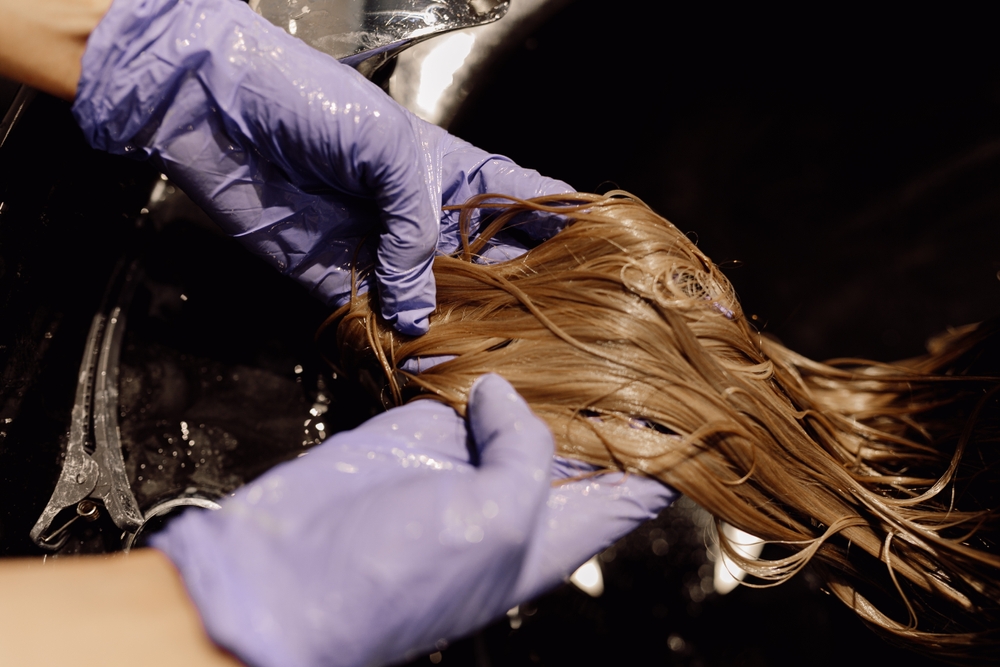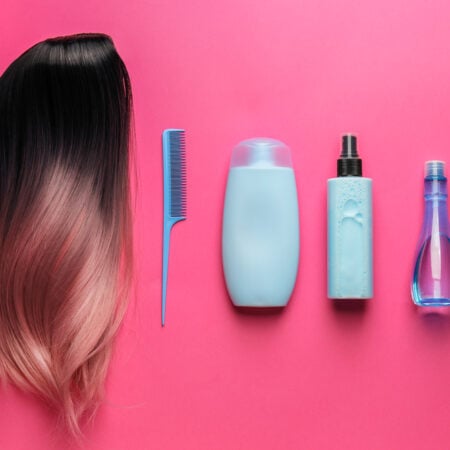Wigs aren’t just accessories; they are a style statement and boost our confidence. But when it comes to caring for them, especially washing them, we often hit a common snag – not having wig shampoo on hand.
Finding the right products for your synthetic wig can be a hassle. Maybe you’ve realized that wig shampoo is harder to come by than you thought, or you’re seeking a more budget-friendly option.
That’s why we’ve crafted this guide to walk you through easy, alternative ways to clean your synthetic wig without needing a specialized shampoo. These are tried and true methods that many wig owners have turned to, using products you likely already have at home.
Understanding Synthetic Wigs
Before diving into the washing process, it’s important to understand what makes synthetic wigs unique. This understanding will help you choose the best cleaning methods to keep your wig looking its best for as long as possible.
Composition and Differences from Natural Hair Wigs
Synthetic wigs are crafted from artificial fibers to mimic the look and feel of natural hair. These fibers, such as acrylic or nylon, are designed to hold their shape and color over time.
Unlike natural hair wigs, synthetic ones don’t react to humidity and retain their style after washing. However, they are more sensitive to heat and can be prone to tangling and frizz if not cared for properly.
Why Regular Hair Care Products Are Not Suitable
As synthetic wigs are unique and have a different material from natural hair wigs, regular hair care products are less effective. Products designed for natural hair can be too harsh for synthetic fibers, leading to damage and a shortened lifespan. That’s why it’s crucial to use products and methods that are gentle and specifically suited for synthetic material.
The Importance of Gentle Care
Synthetic wigs require a delicate touch. Various elements like harsh chemicals, excessive heat, and rough handling damage the fibers. Gentle washing, careful combing, and proper storage are key to maintaining the wig’s appearance.
Understanding this will guide you in selecting the right products and techniques for washing your synthetic wig without needing a specialized wig shampoo.
Pre-Wash Preparations
Preparing your wig is the first step in the cleaning process. This step ensures effective washing, and your wig stays in the best possible condition. Here’s what you need to do:
Detangling: Tools and Techniques:
- Choosing the Right Tool: Use a wide-tooth comb or a special wig brush. These tools are designed to gently detangle without pulling or snagging the synthetic fibers.
- Gentle Detangling: Start from the wig’s ends and work your way up to the roots. This method reduces stress on the fibers and prevents further tangling.
- Avoiding Stretching: Synthetic fibers are more prone to stretching than natural hair. Be gentle and take your time to avoid distorting the wig’s shape.
Checking for Damage:
- Inspecting the Wig: Look for signs of wear, such as fraying or thinning fibers. Identifying areas that need extra care can prevent further damage during washing.
- Addressing Loose Fibers: If you notice any loose strands, carefully trim them or secure them back into the wig cap. Avoid pulling them out.
- Assessing Cap Integrity: Ensure the wig cap is in good shape, without any tears or significant wear. A damaged cap can affect how the wig sits on your head.
What to Use to Wash Your Synthetic Wig
When you don’t have wig shampoo, you can use several household items to clean your synthetic wig safely and effectively. Each alternative has its benefits and methods of use.
Mild Liquid Dish Soap
Dish soap is designed to cut through grease and dirt without being too harsh. A mild, fragrance-free dish soap is a great option for gently cleansing your synthetic wig.
How to Use
Dilute a small amount of dish soap in a basin of cool water. Submerge the wig and gently swish it around. Avoid scrubbing, as this can damage the fibers.
Baby Shampoo
Baby shampoo is formulated to be gentle and is less likely to contain harsh chemicals. It’s a safe alternative for cleaning synthetic wigs.
How to Use
Mix a small amount of baby shampoo in cool water. Immerse the wig, gently moving it around in the soapy water. Rinse thoroughly with cool water.
Fabric Softener
Although not a cleanser, a fabric softener can be used after washing to keep synthetic fibers soft and reduce static.
How to Use
After washing and rinsing the wig, mix a capful of fabric softener in water and soak the wig for ten minutes. Rinse lightly, but leave a bit of softener in to maintain softness.
Each alternative provides a safe and effective way to clean your synthetic wig without using specialized shampoo.
Common Home Cleaning Elements to Avoid for Synthetic Wigs
While there are several household items you can safely use to clean synthetic wigs, there are also some common cleaning elements you should avoid. Using the wrong products causes irreversible damage to synthetic fibers. Here are some items to steer clear of:
- Bleach and Strong Detergents: These can be too harsh for synthetic fibers, leading to brittleness, color fading, and overall degradation of the wig.
- Alcohol-Based Products: Alcohol can dry out synthetic wigs, making them more prone to frizzing and tangling. This includes some hair sprays and styling products.
- Hot Water: Synthetic fibers can be damaged by high temperatures. Washing or rinsing your wig in hot water can cause the fibers to lose shape and texture.
- Chlorine and Swimming Pool Chemicals: Chlorine and similar chemicals can have a harsh effect on synthetic wigs, leading to drying and weakening of the fibers.
- Regular Fabric Softeners and Conditioners: While a diluted fabric softener can sometimes be used for synthetic wigs, regular strength or hair conditioners are often too heavy and can build up on the fibers, making them limp and greasy.
- Abrasive Scrubbing Tools: Avoid using brushes or sponges designed for scrubbing. These are too abrasive and damage the wig fibers.
- Oven Cleaners and Other Harsh Chemicals: These products are too strong for synthetic wig fibers and can cause immediate and severe damage.
- Any Heat Styling Tools: Unless your synthetic wig is specifically labeled as heat-friendly, avoid using blow dryers, straighteners, or curling irons, as the heat can melt or severely distort the fibers.

Step-by-Step Guide to Wash Your Synthetic Wig
Once you’ve selected a suitable alternative cleaning agent and prepared your wig, it’s time to wash it. Following these steps will help ensure that your synthetic wig is cleaned effectively without causing damage.
1. Wetting the Wig
- Fill a Basin with Cool Water: Use lukewarm water to fill a sink or basin. Hot water can damage the wig fibers.
- Submerge the Wig Gently: Lower the wig into the water without soaking it too abruptly. This helps prevent tangling.
2. Applying the Cleaning Agent
- Mixing the Cleaner: If using dish soap or baby shampoo, mix a small amount into the water until it’s sudsy. For fabric softeners, follow the post-wash guidelines instead.
- Gently Clean the Wig: Submerge the wig in the soapy water. Swirl it gently to distribute the cleaner without scrubbing or twisting the wig.
3. Rinsing the Wig
- Rinse with Cool Water: After washing the wig, lift it from the soapy water and rinse it under a stream of cool water. Ensure that all soap residues are removed.
- Patting it Dry: Avoid wringing the wig out. Instead, gently pat it with a towel to remove excess water.
4. Drying the Wig
- Air-Drying: Place the wig on a wig stand or a dry towel and let it dry naturally. Avoid direct sunlight or placing it near heat sources.
- Shaping the Wig: While the wig is damp, gently shape and style it with your fingers or a wide-tooth comb. Avoid using regular hairbrushes.
Post-Wash Care
Just like having your car waxed after washing it to restore the lather and shine, proper post-wash care is essential to keep your wig looking its best. This stage is about conditioning, styling, and storing your wig correctly.
Conditioning the Wig
Conditioning is important to keep the wig fibers soft and reduce static. One effective method is to use a light fabric softener as a conditioner. After washing the wig, soak it in a diluted fabric softener solution, then rinse it lightly. This helps to keep the fibers smooth and manageable.
Alternatively, for a more natural approach, mix vinegar and water (about one part vinegar to four parts water) as a rinse to help the wig maintain its luster.
Combing and Styling
Once the wig is partially dry, comb and style it to shape it like you want. Using a wide-tooth comb or a special wig brush, gently detangle and style the wig, starting from the tips and gradually moving up to the roots.
Remember to avoid using heated styling tools unless your wig is specifically labeled heat-resistant. If you must use heat, opt for the lowest setting and apply a heat protectant to minimize damage.
Storing the Wig
Storing the wig correctly is just as crucial as the washing process. Ensure the wig is completely dry before storage to prevent mold or odor issues. Place it on a wig stand or mannequin to maintain its shape and style.
The storage location should be cool and dry, away from direct sunlight, which can cause the colors to fade. Furthermore, you can cover the wig with a light cloth to protect it from dust and other environmental elements.
Additional Tips and Tricks
Beyond the basic washing and care, some additional tips and tricks help you maintain your synthetic wig in the best possible condition. These suggestions cover everything from the frequency of washing to freshening up older wigs.
Frequency of Washing
It’s important to strike the right balance in how often you wash your synthetic wig. Overwashing leads to wear and tear, while not washing it enough causes build-up and odor.
Generally, washing your wig after every six to eight wears is a good rule of thumb, but this varies depending on how often you use it and the environments it’s exposed to.
Avoiding Common Mistakes
There are a few common mistakes to be aware of when caring for your synthetic wig. Never wash your wig in hot water, as this damages the fibers.
Avoid using regular brushes and combs, which can be too harsh; opt for tools specifically designed for wigs.
Also, be careful not to use too much product, whether it’s a cleaning agent or a styling product, as build-up can make the wig look dull and lifeless.
Reviving Old Wigs
There are ways to revive older synthetic wigs that have started to wear out. Sometimes, a thorough but gentle washing can breathe new life into it. After washing, using a fabric softener can help restore some softness.
For wigs that are losing shape, using steam (carefully and at a distance if the wig is not heat-resistant) helps restore volume and style. Remember, gentle care is key to not further damaging the fibers.

Wrapping It Up: A Farewell to Wig Worries
Your wig is more than just a bunch of synthetic fibers – it’s a part of your daily ensemble and reflects your style. So, the next time you look at your wig, remember that a little care goes a long way.
Taking care of it doesn’t require fancy products or complicated routines. With some basic household items, you can keep your synthetic wig looking as good as new. Whether using a dash of baby shampoo or a splash of fabric softener, these simple yet effective methods make your wig care journey easier and more rewarding.
